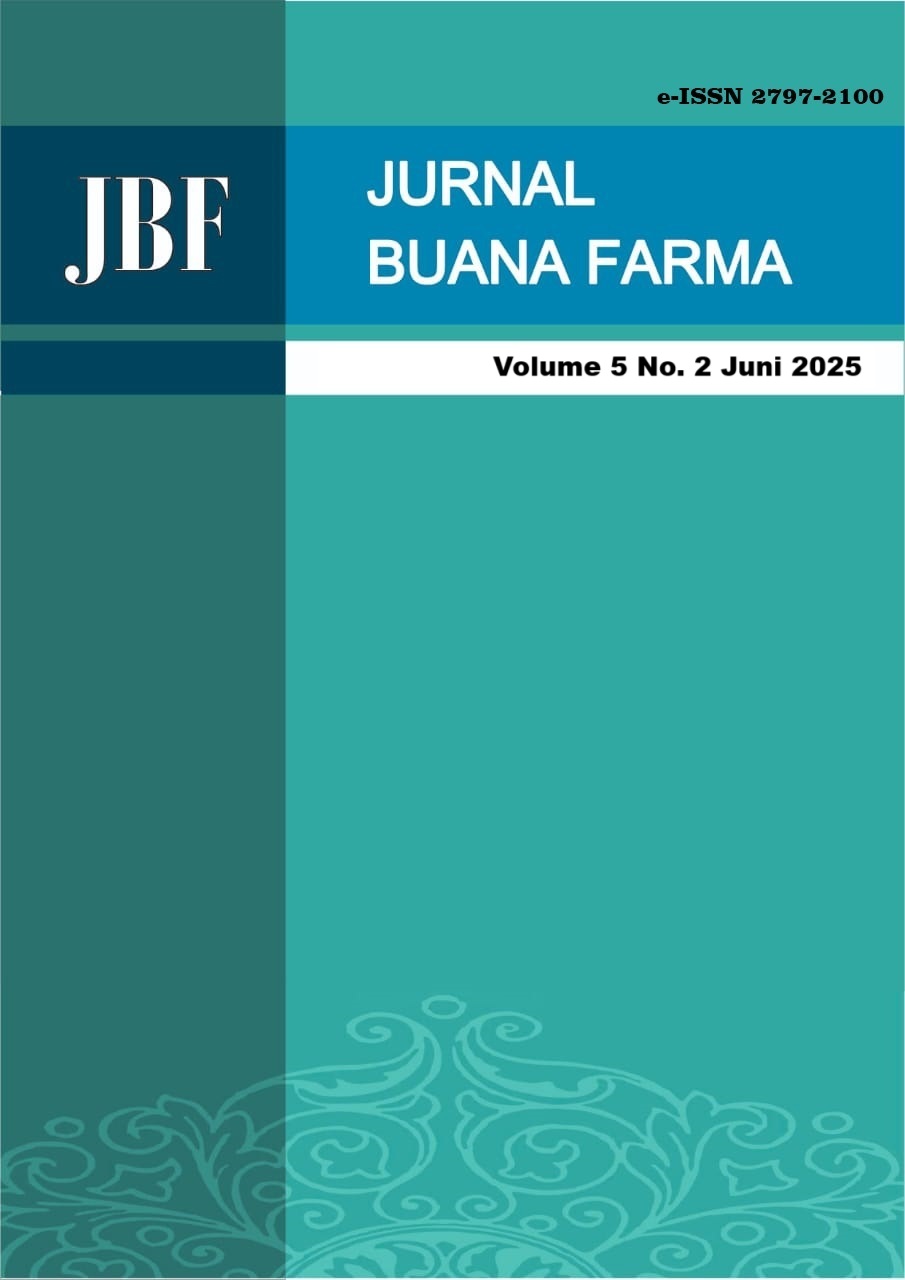EKSPLORASI AKTIVITAS HEPATOPROTEKTIF EKSTRAK ETANOL TEMU KUNCI (Boesenbergia rotunda) MELALUI PARAMETER MAKROPATOLOGI ORGAN HATI DAN INDEKS ORGAN PADA MODEL HEPATOTOKSISITAS TIKUS
Abstract
Hati merupakan organ paling berperan dalam mayoritas sistem metabolisme pada tubuh. Metabolisme N-acetyl-p-aminophenol (APAP) memiliki metabolit reaktif N-acetyl-p-benzoquinone imine (NAPQI) yang dapat menyebabkan berkurangnya antioksidan glutation hati serta disfungsi mitokondria dan mengakibatkan meningkatnya jumlah radikal bebas dihati, yang pada akhirnya akan merusakkan hati. Antioksidan dibutuhkan guna meminimalisir radikal bebas. Rimpang temu kunci (Boesenbergia rotunda (L.) Mansf) mengandung metabolit sekunder berupa flavonoid yang diketahui memiliki sifat antioksidan sehingga rimpang temu kunci memiliki potensi untuk melindungi hati dari kerusakkan. Penelitian ini bertujuan untuk menganalisis aktivitas hepatoprotektif ekstrak etanol rimpang temu kunci terhadap tikus putih jantan yang diinduksi dengan APAP.
Tikus putih jantan sebanyak 24 ekor digunakan pada penelitian ini, tikus dibagi dalam 6 kelompok perlakuan yakni kelompok kontrol normal, kontrol negatif diberi CMC-Na 0,5%, kelompok uji diberi ekstrak etanol rimpang temu kunci (EERTK) dosis 250, 500 serta 750 mg/kgBB dan kelompok kontrol positif diberi asetilsistein 200 mg. Selama 10 hari berturut-turut. Pada hari kesepuluh diinduksi dengan APAP 800 mg/kgBB secara oral. Setelah 16 jam, dilakukan pembedahan dan pengambilan organ hati. Organ hati untuk pengukuran indeks relatif organ dan makropatologi organ hati. Data dianalisis menggunakan one way-ANOVA lalu dilanjutkan Post Hoc Turkey HSD. Hasil analisis menjelaskan bahwa pretreatmen dengan EERTK secara signifikan menyebabkan indeks relatif organ hati menurun akibat dari pemberian EERTK, disisi lain EERTK juga memperbaiki makropatologi organ hati.
References
Abubakar, A. R., & Haque, M. (2020). Preparation of Medicinal Plants: Basic Extraction and Fractionation Procedures for Experimental Purposes. Journal of Pharmacy and Bioallied Sciences, 12(1), 1–10. https://doi.org/10.4103/jpbs.JPBS_175_19
Alim, N., Hasan, T., Rusman, R., Jasmiadi, J., & Zulfitri, Z. (2022). Phytochemical Screening, Relationship of Total Phenolic with Antioxidant Activity Of Ethanol and Methanol Extracts of Kesambi (Schleichera oleosa (Lour.) Oken) Bark. JURNAL ILMIAH SAINS, 22(2), 118. https://doi.org/10.35799/jis.v22i2.40091
García‐Román, R., & Francés, R. (2020). Acetaminophen‐Induced Liver Damage in Hepatic Steatosis. Clinical Pharmacology & Therapeutics, 107(5), 1068–1081. https://doi.org/10.1002/cpt.1701
Gonfa, Y. H., Bachheti, A., Semwal, P., Rai, N., Singab, A. N., & Bachheti, R. K. (2024). Hepatoprotective activity of medicinal plants, their phytochemistry, and safety concerns: a systematic review. Zeitschrift Für Naturforschung C. https://doi.org/10.1515/znc-2024-0116
Harahap, M. S., Harahap, U., & Sitorus, P. (2023). Phytochemical Screening Of Ethanol Extract Of Temu Kunci (Boesenbergia Rotunda (L.) Mansf) Rhizome Extract And Testing Of Bilirubin Levels In Male White Mice. International Journal of Science, Technology & Management, 4(3), 582–588. https://doi.org/10.46729/ijstm.v4i3.819
INDRIATY, I., DJUFRI, D., GINTING, B., & HASBALLAH, K. (2023). Phytochemical screening, phenolic and flavonoid content, and antioxidant activity of Rhizophoraceae methanol extracts from Langsa, Aceh, Indonesia. Biodiversitas Journal of Biological Diversity, 24(5). https://doi.org/10.13057/biodiv/d240541
Jaeschke, H., & Ramachandran, A. (2024). Acetaminophen Hepatotoxicity: Paradigm for Understanding Mechanisms of Drug-Induced Liver Injury. Annual Review of Pathology: Mechanisms of Disease, 19(1), 453–478. https://doi.org/10.1146/annurev-pathmechdis-051122-094016
Kim, S. R., Kim, S. K., Kobayashi, H., Okuda, T., Nakai, A., Fujii, Y., Hayakumo, T., Suzuki, R., Otani, A., Sasase, N., Kim, K. I., Sasaki, M., Koma, Y., Asai, A., & Nishikawa, H. (2024). Acetaminophen-induced liver injury with atypical histopathologic findings: a case report. Kanzo, 65(2), 74–80. https://doi.org/10.2957/kanzo.65.74
Kumar Jain, N., & Singh, N. (2023). Hepatoprotective Role of Herbs and Herbal Formulations. In Plant-derived Hepatoprotective Drugs (pp. 81–114). BENTHAM SCIENCE PUBLISHERS. https://doi.org/10.2174/9789815079845123010006
Liao, J., Lu, Q., Li, Z., Li, J., Zhao, Q., & Li, J. (2023). Acetaminophen-induced liver injury: Molecular mechanism and treatments from natural products. Frontiers in Pharmacology, 14. https://doi.org/10.3389/fphar.2023.1122632
Mahmood, F., & Hackl, F. (2024). Hepatic Function and Metabolism. In A. Abd-Elsayed (Ed.), Basic Anesthesia Review (pp. 707–708). Oxford University PressNew York. https://doi.org/10.1093/med/9780197584569.003.0290
Rusmaladewi, A., & Istanto, W. (2014). Pengaruh Pemberian NAcetylcysteine terhadap Kadar SGOT dan SGPT pada Tikus Wistar yang Diberi Parasetamol. Medica Hospitalia : Journal of Clinical Medicine, 2(2), 78–83. https://doi.org/10.36408/mhjcm.v2i2.96
Shanmugam, G., Ayyavu, M., Rao, D. M., Devarajan, T., & Subramaniam, G. (2013). Hepatoprotective effect of Caralluma umbellate against acetaminophen induced oxidative stress and liver damage in rat. Journal of Pharmacy Research, 6, 342–346.
Stavrakeva, K., Popova, M., Esad, M., Apostolova, E., Kokova, V., Bacelova, M., Alakidi, A., & Bivolarska, A. (2024). Drug-Induced Liver Toxicity. Acta Medica Bulgarica, 51(4), 77–85. https://doi.org/10.2478/amb-2024-0083
Sugiharto, S., Faradila, D., Rizqi Aningrum, K., Nur Hakiki, F. D., Zahrotus Sa’adah, A., Fatimatuz Zahroh, U., Soepriandono, H., & Sri Wulan Manuhara, Y. (2024). Potential of Jahe Merah (Zingiber officinale) and Temu Kunci (Boesenbergia rotunda): As Stimulator of Antioxidant Enzyme Activity and Anticancer in HepG2 Cell Line. Research Journal of Pharmacy and Technology, 3599–3606. https://doi.org/10.52711/0974-360X.2024.00562
Villanueva-Paz, M., Morán, L., López-Alcántara, N., Freixo, C., Andrade, R. J., Lucena, M. I., & Cubero, F. J. (2021). Oxidative Stress in Drug-Induced Liver Injury (DILI): From Mechanisms to Biomarkers for Use in Clinical Practice. Antioxidants, 10(3), 390. https://doi.org/10.3390/antiox10030390
Xu, Y., Xia, Y., Liu, Q., Jing, X., Tang, Q., Zhang, J., Jia, Q., Zhang, Z., Li, J., Chen, J., Xiong, Y., Li, Y., & He, J. (2023). Glutaredoxin-1 alleviates acetaminophen-induced liver injury by decreasing its toxic metabolites. Journal of Pharmaceutical Analysis, 13(12), 1548–1561. https://doi.org/10.1016/j.jpha.2023.08.004
Zayapor, M. N., & M., S. (2023). Herbal infusion – processing techniques, bioactivity, quality, and safety. Food Research, 6(Supplementary 2), 134–154. https://doi.org/10.26656/fr.2017.6(S2).019













